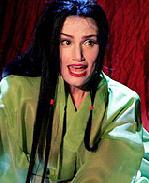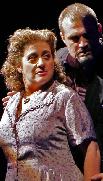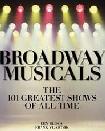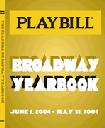SEARCH
REVIEWS
FEATURES
NEWS
Etcetera and
Short Term Listings
LISTINGS
Broadway
Off-Broadway
BOOKS and CDs
OTHER PLACES
Berkshires
London
LA/San Diego
Philadelphia
Elsewhere
QUOTES
On TKTS
LETTERS TO EDITOR
FILM
LINKS
MISCELLANEOUS
Free Updates
Masthead
Writing for us
A CurtainUp Review
See What I Wanna See
By Elyse Sommer
|
Look at the world If there's a god You'd think he'd do something to stop all the war and the crime And the Graft And he'd punish those sonovabitches Who write all those Stupid new TV shows --- Aunt Monica in her show stopping "The Greatest Practical Joke." |

Idina Menzell in "Kesa & Morito"
(Photo: Michael Daniel ) |
Mr. LaChiusa's musical interpretation of three stories by Ryunosuke Akutagawa hasn't changed too much from the showcase production I saw at the Williamstown Theater two summers ago. The dialogue is still minimal, leaving his wonderfully jazzy score and art songs to tell the stories. The two main tales play out in a modern setting so that only the slightest, "Kesa & Morito," conveys the Japanese flavor of the source material. Yet, LaChiusa's theme for his musical triptych, the mystery and elusiveness of truth, drives even this less fully realized tale of two adulterous lovers in medieval Japan.
Rather than allowing "Kesa & Morito" to seem slight in comparison to the longer stories, its fragmentary quality is smartly emphasized by breaking it into two parts, with each serving as an atmospheric overture. Kesa's version of the fatal last tryst with Morito precedes R shomon, a film noir version of Akutagawa's "In the Grove" in which four people giving their accounts of a savage murder. With its 1951 time frame and a murder victim who's a foreign film fan this is a clever tip of the hat to filmmaker Akira Kurosawa's 1950 classic Rashomon which made that title word a common allusion for puzzlement caused by conflicting viewpoints of an event. Morito's version serves as a prelude to the final and most emotionally powerful "Gloryday" which, like "R Shomon" is also set in New York City, but in the present. Short as they are these interludes do tie everything to the ancient Japanese value system. Best of all, they are marvelously melodic and visually striking.
While both the music and libretto represents Mr. LaChiusa at his most accessible, that doesn't mean this is Fiddler on the Roof or South Pacific, with straightforward plot and sing-in-the-shower tunes. The appeal here is to devotees of serious modern musicals.
As with any stage adaptation of short stories, some are harder to bring off flawlessly than others. Thus, the need to reinforce faith and hope ("Gloryday") has more emotional resonance and relevance than the noirish "see what you wanna see" accounts of the murder of a businessman done in by greed and too many martinis -- especially given the haunting opening scene in which the "Gloryday" ensemble's "Last Year" mirrors the universal despair over 9/11. That said, the adaptation ingeniously illustrates the disconnect between R Shomon's murder victim and his glamorous wife by making him a foreign film buff and having the murder coincide with the premiere of Kurosawa's Rashomon. The R shomon, title is a savvy double bow -- to the Kurosawa film and the dropped marquee letter that turned the Hotel Baltimore into Lanford Wilson's Hot L Baltimore.
When I saw this show (then title R shomon) at the Williamstown Theater Festival, the state of the art second stage had not yet been built, and when I interviewed Mr. LaChiusa, he talked about the less than ideal acoustics of that venue. He hoped that if the show went on to a longer running production, it would be in a space small enough to accommodate its intimacy but without the acoustical problems. The Anspacher Theater fulfills that hope beautifully.

Mary Testa & Marc Kudisch in "In the Grove"
(Photo: Michal Daniel) |
Fortunately, Mary Testa and Henry Stram, two standouts at Williamstown, are in this production, both better than ever. In fact, if I had to give you a single reason to see this production it would be to catch Testa's cynical Aunt Monica in her thrilling, show-stopping "The Greatest Practical Joke" at the top of " Gloryday." The unassuming looking Stram is also terrific and poignant as Aunt Monica's nephew, the miracle seeking priest.
The other newcomers to the 5-member cast, Marc Kudisch and Aaron Lohr, are excellent actors as well as singers. Kudisch has some fine duets with Menzel in the Kesa & Morito segments, and is also stunningly paired with Testa (as a psychic who can speak to the dead) in a R Shomon duet.
The stagecraft -- Thomas Lynch's spare design, effectively lit by Christopher Akerlind, and Elizabeth Caitlin Ward's right for each period costumes -- is impeccable. Conductor/pianist Chris Fenwick's small band brings out the best in the score that's been expertly orchestrated by Bruce Coughlin to bring out the best in the score, whether pulsating with emotion or hot and jazzy. It all adds up to a musical evening that's, dare I say it -- art-y, but most of all, artfully entertaining and always melodic.
Postscript: The Kurosawa film was also adapted for the stage in 1959. It had a 159-performance run at the Music Box and featured Claire Bloom, Oscar Homolka, Rod Steiger and Akim Tamiroff.
La Chiusa first wrote a very different version of "In the Grove" a dozen years ago but didn't get to the second story until 9/11 when the universal yearning for some sort of miracle assumed new immediacy. Readers might want to check out my interview with Michael John LaChiusa after I saw the showcase production of this show ---The Interview.
Following are links some LaChiusa works reviewed at CurtainUp:
The Wild Party
First Lady Suite
Little Fish
Marie Christine
Requiem for William (a rare example of a show in which the composer's involvement was one song
| SEE WHAT I WANT TO SEE Music and Lyrics by John La Chiusa Based on the stories of Ryunosuke Akutagawa stories as translated by Takashi Kojima ("In the Grove", "Gloryday" & "The Dragon" Directed by Ted Sperling. Cast: Idina Menzel (Kesa, the Wife and an Actress), Marc Kudisch (Morito, the Husband and a C.P.A.), Aaron Lohr (the Thief and a Reporter); Henry Stram (the Janitor and a Priest) and Mary Testa (the Medium and Aunt Monica) Sets: Thomas Lynch Costumes: Elizabeth Caitlin Ward Lights: Christopher Akerlind Sound: Acme Sound Partners Musical Staging: Jonathan Butterell Orchestrations: Bruce Coughlin Director/Conductor/pianist: Chris Fenwick Musicians: Rodd Groves, Reed 1; John Winder, Reed 2; Mark Vanderpoel, Bass; Diana Herold, Mark Sherman, Percussons; Norbert Goldberg, Drums Running time: Approx. 1 hour and 40 minutes, plus one intermission Public Theatre/Anspacher, 420 Lafayette St. 212/239-6200 From 10/11/05 to 11/20/05--pre-opening extension to 12/04/05. Tuesday to Saturday @ 8pm, Wednesday, Saturday & Sunday @ 2pm Tickets: $60. Reviewed by Elyse Sommer based on October 28th press performance performance |
|
Musical Numbers
| |
Act One
R SHOMON The Janitor's Statement The Thief's Statement The Wife's Statement The Medium and Husband's Statement |
Act Two
|

Easy-on-the budget super gift for yourself and your musical loving friends. Tons of gorgeous pictures.

>6, 500 Comparative Phrases including 800 Shakespearean Metaphors by our editor.
Click image to buy.
Go here for details and larger image.








